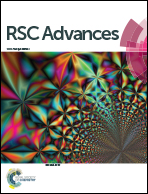A DFT based prediction of gold fullerene Au92Si12 with the aid of silicon
Abstract
Structural evolution of the gold Bucky ball Au92Si12 has been studied via a systematic investigation of AunSi clusters within the framework of DFT with spin-polarized generalized gradient approximation (GGA). Beginning with low energy isomers of Aun (n = 1–16), we find that Si, being hypervalent, can attach onto the Au cluster in more than one valence configuration, leading to several possible geometrical arrangements of surrounding Au atoms. One such geometry has a Au–Si unit dangling over a quasi-planar arrangement of gold atoms. It is observed that a pentagonal unit of gold atoms attached with a Au–Si dangling unit can only exist in the presence of other neighbouring gold atoms to present a quasi-planar cluster. By repeating such quasi-planar clusters, a stable geometry of golden Bucky ball Au92Si12 with a binding energy per atom (Eb/n) of 3.814 eV and a HOMO–LUMO gap (Eg) of 0.6 eV has been optimized. The current work suggests the exciting possibility of a golden Bucky ball that has the same rotational symmetry as the C60 molecule with a much larger volume.


 Please wait while we load your content...
Please wait while we load your content...